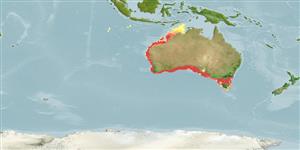Teleostei (teleosts) >
Mulliformes (Goatfishes) >
Mullidae (Goatfishes)
Etymology: Upeneichthys: Greek, ypene, -es = upper lip + Greek, ichthys = fish (Ref. 45335).
Eponymy: Admiral Cornelis Willemsz de Vlamingh (<1678–1735) was a Dutch explorer and naval officer. [...] (Ref. 128868), visit book page.
More on author: Cuvier.
Issue
FishBase common name changed from Bluespotted goatfish to Blue-spotted goatfish (Uiblein et al., 2024: Ref. 130857).
Environment: milieu / climate zone / depth range / distribution range
Ecology
Marine; demersal; depth range 1 - 100 m (Ref. 9002). Subtropical
Eastern Indian Ocean: southern Australia. This species has often been confused with Upeneichthys lineatus (Bloch & Schneider, 1801) occurring in the eastern coast of Australia (Ref. 33839).
Size / Weight / Age
Maturity: Lm ? range ? - ? cm
Max length : 35.0 cm TL male/unsexed; (Ref. 9002)
Inhabits shallow sandy coastal waters (Ref. 33839); also rocky estuaries (Ref. 9002). Forms schools (Ref. 9002). Good food fish (Ref. 33839).
Life cycle and mating behavior
Maturity | Reproduction | Spawning | Eggs | Fecundity | Larvae
Gomon, M.F., C.J.M. Glover and R.H. Kuiter (eds.), 1994. The fishes of Australia's south coast. State Print, Adelaide. 992 p. (Ref. 33839)
IUCN Red List Status (Ref. 130435: Version 2024-1)
Threat to humans
Harmless
Human uses
Tools
Special reports
Download XML
Internet sources
Estimates based on models
Preferred temperature (Ref.
123201): 14.6 - 27.4, mean 18 °C (based on 300 cells).
Phylogenetic diversity index (Ref.
82804): PD
50 = 0.6250 [Uniqueness, from 0.5 = low to 2.0 = high].
Bayesian length-weight: a=0.01023 (0.00493 - 0.02126), b=3.10 (2.93 - 3.27), in cm total length, based on LWR estimates for this (Sub)family-body shape (Ref.
93245).
Trophic level (Ref.
69278): 3.5 ±0.5 se; based on size and trophs of closest relatives
Resilience (Ref.
120179): Medium, minimum population doubling time 1.4 - 4.4 years (Preliminary K or Fecundity.).
Fishing Vulnerability (Ref.
59153): Low vulnerability (25 of 100).
Nutrients (Ref.
124155): Calcium = 93.8 [52.8, 194.0] mg/100g; Iron = 1 [0, 2] mg/100g; Protein = 18.5 [16.8, 20.1] %; Omega3 = 0.398 [0.254, 0.700] g/100g; Selenium = 26.3 [14.2, 47.8] μg/100g; VitaminA = 14.1 [4.7, 49.3] μg/100g; Zinc = 0.787 [0.481, 1.106] mg/100g (wet weight);
